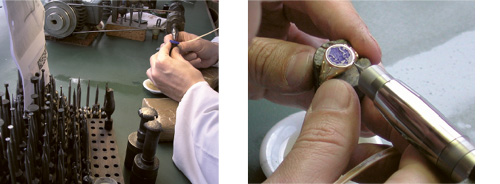Glyptic Art
The art of stone engraving. The term derives from the greek word glyphein = to hollow out or engrave, which is also hidden in hieroglyph (hieros = holy).
Our engravers are undisputed masters of the art, combining highest artistic values with almost unbelievable craftsmanship. The standards of precision and perfection they set for their work are so high, they actually manufacture all their tools themselves because the readily available tools do not run smoothly enough for the purpose. Whether spherical, discoid, tapered or needle-shaped, all drills are handmade on the engraver’s lathe
Surprisingly enough and contrary to goldsmithing, it is not the drill that is moved. In engraving the stone to be engraved is pressed gently onto the drill, rotating in the lathe at 3000 to 5000 rpm. Only for engraving very large objects e.g. vases, flexible shafts are used. So the whole process is performed freehandedly!

The cutting and grinding is achieved by a mixture of oil and diamond powder that is applied every few seconds by means of a quill. By the way, our engravers even grind the diamond themselves because even the most fine-grained powder available on the market, measuring 0 – 0.5 microns and used to polish the hardest gems, does not meet their standards.
The engraving process itself is of nerve-wrecking slowness. With full coats of arms with shield, helmet, crest, mantling and maybe even a motto scroll, progress is measured in tenths of a millimeter.
The hardness of gemstones is a factor not to be underestimated, either. The classic layered stone registers a “mere” 7 on Mohs´ scale of hardness but often enough the order is for tourmalines, spinels or even sapphires. In addition to accuracy patience is a cardinal virtue every engraver must possess.
 Deutsch
Deutsch